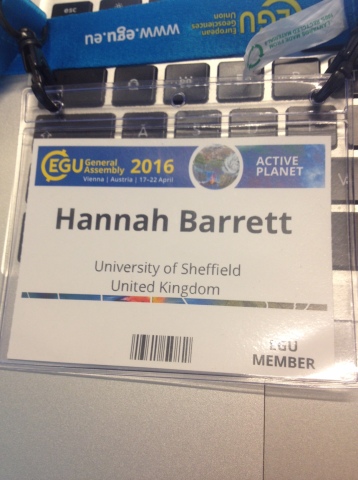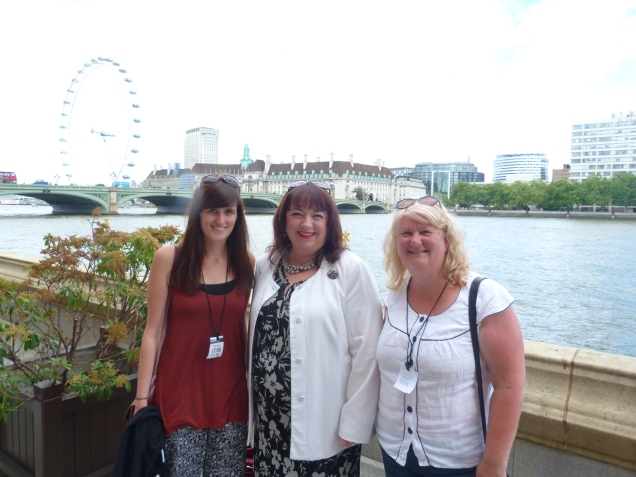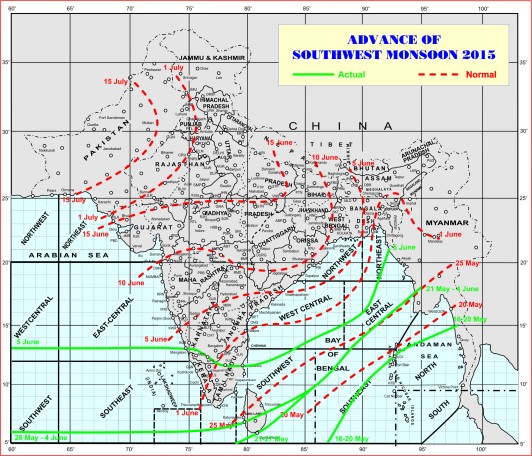El Niño: What’s all the fuss about?
Just a couple of weeks ago I was helping out on a undergraduate course where we looked online to assess the current state of El Niño and its forecast for the year ahead. Conditions and forecasts issued by US scientists at the National Oceanic and Atmospheric Administration (NOAA) in March 2015 were currently up and they were suggesting we were in a ‘weak El Niño’. This was declared because observations suggested that sea surface temperatures (SSTs) over a key region of the Pacific Ocean were higher than normal and the atmosphere was also starting to kick into El Niño conditions. This led to an ‘El Niño advisory’ being issued on March 5th.
On the 12th May 2015, it was the turn of the Bureau of Meteorology in Australia to officially announce that we had entered an El Niño. They suggested that this El Niño has potential to be a ‘substantial’ event. This was announced via their website and on Twitter, with the following post showing that their ENSO tracker had been moved to El Niño;
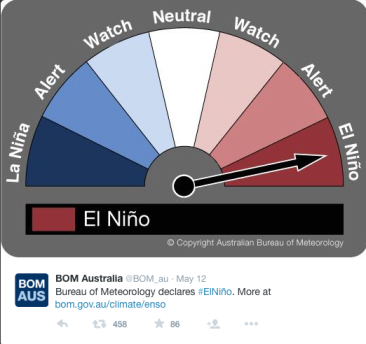
As a result of this announcement, numerous news articles were published from around the globe, warning people of El Niño and postulating the range of implications this may have on our weather world-wide. It seems that public interest in El Niño increased rapidly, with the term ‘El Niño’ being the 4th most searched for term on Google in the UK the day following the announcement, with over 10,000 searches, shown in this daily summary from Google trends website:

What is this El Niño? What does it mean for us and the rest of the world? How will it affect the weather? These are all questions addressed by the flurry of news reports published over the last few days.
Here is a quick summary of the answers to these questions based my own understanding as well as from numerous articles, interviews and videos published by the media over the past few days.
This BBC video (http://www.bbc.co.uk/weather/feeds/29559386) nicely summarizes El Niño, which is essentially an abnormal warming of the tropical Pacific Ocean which leads to altered weather patterns around the globe. It is a naturally occurring phenomenon which appears every 2 to 7 years. All El Niño events are different but there are typical weather conditions that become more likely during an El Niño. The impacts of El Niño are centered over the Pacific, but it has implications for weather patterns around the globe. Here are some of the impacts typical of El Niño events:
- Drier conditions over Australia, Indonesia and India which can lead to wildfires, smog and lower crop production.
- Increased precipitation over regions of South America and the Eastern Pacific leading to flooding and landslides.
- Weaker than normal Indian Monsoon causes drought which can vastly reduce crop yields. El Niño causes uncertainty in the predictions of crop yields leading to fluctuations in agricultural commodities markets.
- El Niño can affect the position of the North Atlantic jet stream, a key driver of weather in the UK. A more southerly jet stream, thought to be more common during El Niño, can lead to cooler winters. However the links between El Niño and weather patterns is stronger in regions closer to the Pacific, and additional factors influencing the UK weather mean the effect of El Niño is less clear in the UK than in other regions.
- As I found out whilst doing my undergraduate dissertation, El Niño is bad news for skiers in Pacific Coast Canada, with ski resorts in Vancouver and Whistler often suffering during El Niño due to warmer winter conditions resulting in less snowfall. This was an issue for the 2010 Winter Olympics held in Vancouver, when El Niño conditions contributed to poor snow coverage on Vancouver’s North Shore Mountains. Extra snow had to be transported in from colder regions in the province.
- El Niño can also have an effect on the worldwide production of cocoa! The graph below from the International Cocoa Organization’s 2010 report shows that in many recent El Niño years (indicated in red), the annual production of cocoa worldwide was reduced.
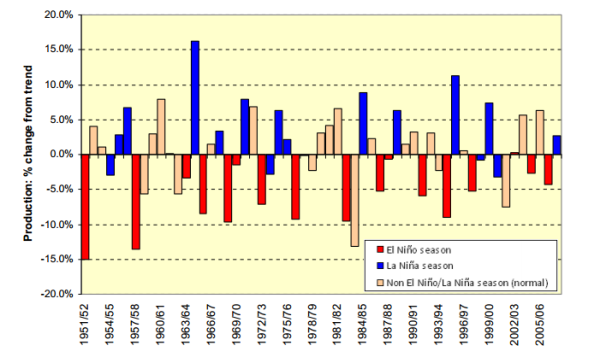
These are just some of the impacts certain El Niño events have had in the past which give an idea of what we might expect if this El Niño event develops over the next few months and into the winter.
So how do we know what El Niño will do over the next year?
A range of climate models and statistical techniques are used to forecast the future of El Niño. Here is the most recent forecast from the International Research Institute for Climate and Society, taken from NOAA’s ENSO bulletin. It shows the range of projected sea surface temperature (SST) anomalies in a key region (NINO 3.4) of the equatorial Pacific which experiences warm anomalies during El Niño. The two black dots shows recent observations of SST’s, with SSTs being warmer than normal already and this warming expected to increase over the next few months in most of the models. However, the forecasts on the graph show there is still a lot of uncertainty over which path the El Niño event may take, with some of the projections suggesting that SSTs might reach over 2 degrees warmer than normal, while others suggest the warming of the ocean in this region may actually cool. Therefore there is still uncertainty on how strong this El Niño event might be and how large its impacts might be.
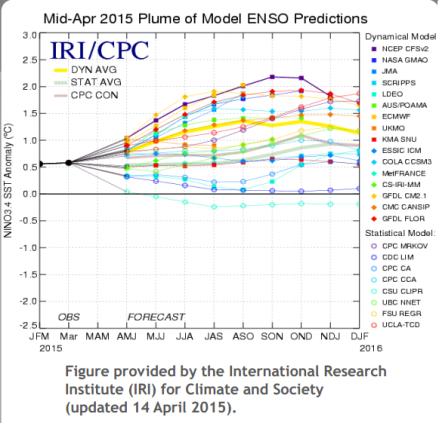
This post (http://www.climate.gov/news-features/blogs/enso/spring-predictability-barrier-we’d-rather-be-spring-break) from Michelle L’Heureux, a scientist at NOAA, explains the so-called ‘spring predictability barrier’, which means that El Niño forecasts made in Northern Hemisphere spring time are less accurate than those published at other times of the year. Therefore additional caution is needed when looking at these spring-based forecasts.
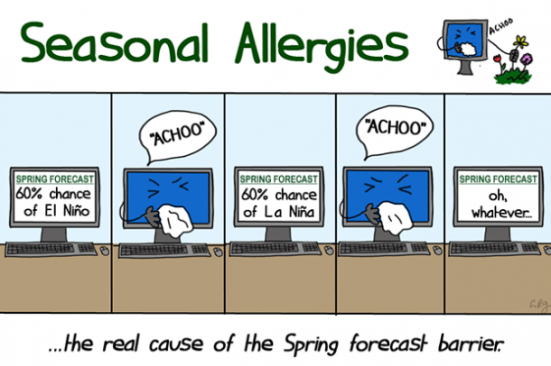
Illustration by Emily Greenhalgh, NOAA Climate.gov.
An example of the uncertainty in forecasts published at this time of year can be seen when looking at the forecast from last year. Below is the forecast from Mid-April 2014, when warmer SSTs were predicted in the key tropical Pacific region suggesting a move into El Niño conditions. However, observations throughout the year showed that this failed to result in El Niño conditions last year.

Some news articles are picking up on this point, and highlighting caution after 2014’s ‘false alarm’. So how is this year different to last year? We already have warm SSTs over the Pacific, whereas last year the waters in this key El Niño region were cooler than normal. This could be a key factor which will lead to this year’s El Niño developing further. However the main thing to remember is that the ability of models to forecast El Niño is low in the spring months, so as we progress into summer the forecasts for El Niño will become less uncertain and we will have a better idea of how this El Niño event might unfold and how strong an event it may be.
To keep up to date with the development of this El Niño over the next few months the following two websites are good places to start:
Australian government’s Bureau of Meteorology, next updated on 26th May http://www.bom.gov.au/climate/enso/
&
ENSO Diagnostics Bulletin by NOAAs Climate Prediction Centre http://www.cpc.ncep.noaa.gov/products/analysis_monitoring/enso_advisory/ which issues weekly and monthly information on the current state of El Niño.
I will be using this blog to post about interesting climate and weather related things I come across as part of my PhD research which is focused on El Niño and historical climate variability. So no doubt El Niño will be popping up again. Hope to see you again soon!
Links to some of the interesting sources used and referenced:
Useful BBC resources:










